"Ceramic dish, Minā’ī technique decorated with inscriptions, human, animal and floral motifs depicting Persian stories
Iran
6th-7th A.H /12th-13th A.D century
MIA no. 14345"
"The Minā’ī ceramic is defined as a polychrome under glazed decorated ceramic. It is called “Hefet Rank” in Persian which means the spectrum of colors. It is one of the famous types of Persian ceramics produced in numerous Iranian cities. It is characterized by its variety of decorative subjects inspired by the literary Iranian stories, and the Seljuk school of miniatures which often adopted the idea of gilding. The story of the seven princesses, the story of Bahram Gur and Azdah, in addition to numerous miniatures of princes and princesses of the royal court, scenes of hunting, fighting and singing are just some examples. The Turkish influence on Minaʾī ceramics is clear the chubby Turkish faces with fair skin, flowing hair and long whiskers. This style was also characterized by the depiction of animals such as camels, fish and the like, in addition to mythical creatures and humanoids with a human face on a lion’s body. The rims of the dishes were embellished by an epigraphic frieze describing the main subject displayed on the artifact. The artisan didn’t ignore the adornment of these dishes with various vegetal designs that reached a very high standard of precision and perfection.
hall 15"
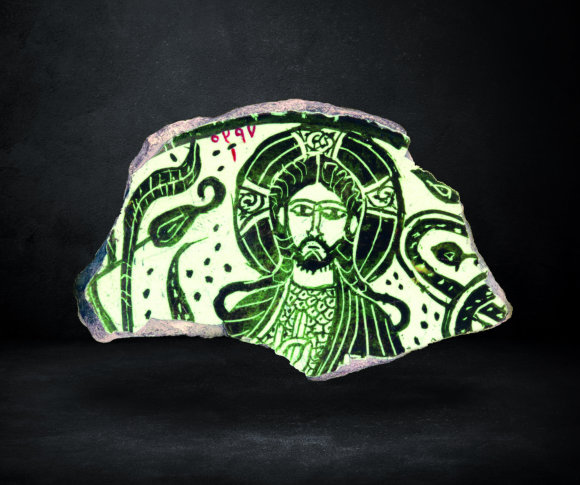
"Luster painted ceramic shard decorated with a scene of the Christ as an evidence of the Moslem tolerance
Egypt - Fatimid
4th - 5th A.H /10th -11th A.D century
MIA no. 5397"
"This fragment depicts what is believed by some to be the portrait of Jesus Christ, with a beard and long hair, carrying a book ,thought to be the Bible, bestowing his blessings with his right hand. His two fingers symbolize the dual nature of Jesus, and some researchers believe that his other three fingers symbolize the two letters Alpha and Omega, as mentioned in the Apocalypse of St.John. This scene is repeated in Coptic Art in the wall paintings of the monastery of Bawīt, in Upper Egypt, 5th century AD, which reflects the religious tolerance towards non Moslems in the Fatimid period.
hall 2"
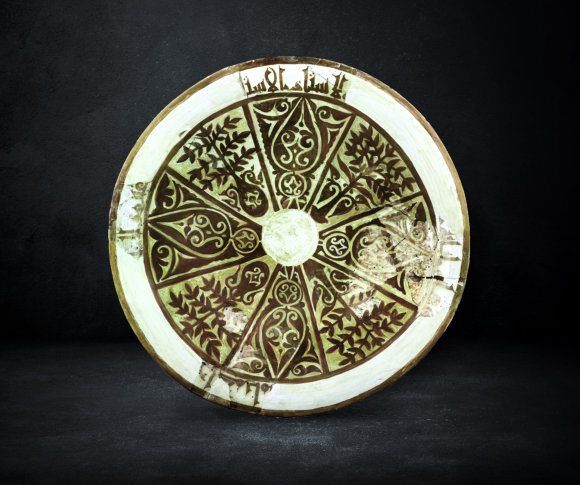
"Luster painted ceramic dish
in the name of Commander Ghabn, with inscription and floral decoration
Egypt – Fatimid
5th A.H /11th A.D century
MIA no. 12997"
"This dish is considered the biggest of all ceramic plates in Islamic Art, decorated with stylized vegetal motifs and Kufic writing on the inner rim which says: “ The master Ghabn..Lord , Ḥakim bi’ Amr …on his fathers” . This refers to one of the army commanders in the reign of al-Ḥākim bi’ Amr Allah.
hall 3"
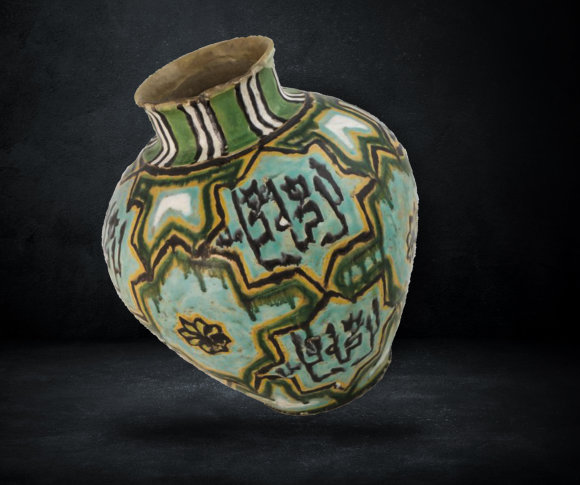
"ceramic jar, so - Called Fayoum ceramic decorated with floral, geometric and epigraphic motifs of various colors.
Egypt – Fatimid
4th - 5th A.H / 10th - 11th A.D century
MIA no. 15980"
Read More >"This pot is decorated with vegetal, geometric, and epigraphic motifs and a phrase saying” Barakah kāmilah” or “a complete blessing”. This type of pots was characterized by its variety of colors such as, green, blue, yellow, and brown
hall 4"
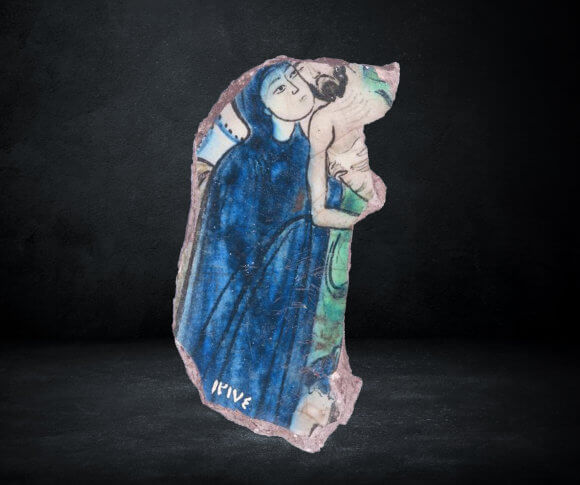
"Ceramic shard, painted under glaze,
decorated with the scene of descending Jesus after crucifixion holding by virgin Mary
Egypt or Syria – Ayyubid
7th A.H / 13th A.D century
MIA no. 13174"
Read More >"This piece is considered the most important masterpiece of Ayyubid ceramics in the world. It is decorated with a Coptic scene depicting Jesus Christ(pbuh) and the Virgin Mary. Its complementary part is preserved in the Benaki Museum in Athens and depicts the apostles of Jesus Christ(pbuh). Its unique historical value stems from the fact that it is an undeniable physical evidence of Moslem tolerance to other faiths, at a time when the Crusading armies were attacking the Islamic World.
hall 6"
" Shard decorated with blazon
pottery, incised through slip, painted under glaze
Egypt – Mamluk
8th A.H /14th A.D century.
MIA no. 5146/3"
"The term “rank” (blazon or coat of arms) is derived from a persian word which means a sign, or color. It is among the pivotal decorative elements distinguishing the mamluk art and architecture.
hall 8"
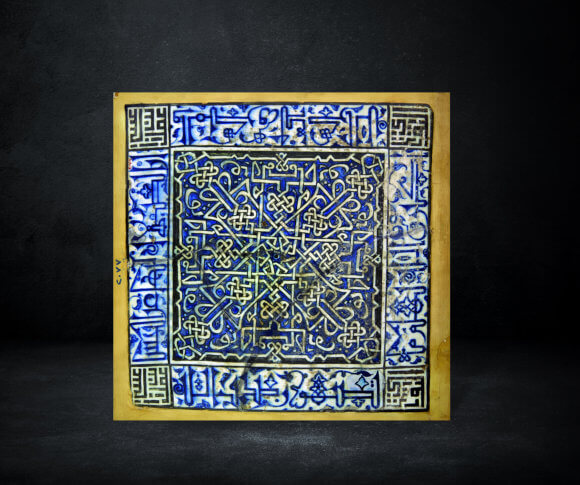
"Ceramic tile, decorated with floriated and plaited Kufic inscriptions from the Holy Quran and the craftsman name in quadrangular Kufic “ Ghaiby ibn al-Tawrizi”
Egypt– Mamluk
8th A.H /14th A.D century
MIA no. 2077"
"This tile is one of the most famous of all mamluk tiles as it bears the name of the ceramicist Ghayby al-Tawrīzī who has his name written in quadrangular Kufic script on the four corners of the tile. These inscriptions reflect the mastery of the Moslem artisan in including the written script as a central element in decoration. It also reflects his talent in rendering the script one of the principal characteristic aspects of Islamic Art. An inscription band lies in the center of the piece and reads: “trust the most helpful”, repeated eight times. The outer rim is decorated with a verse from the Quran which reads:”Indeed, prayer prohibits immorality and wrongdoing, and the remembrance of Allah is greater, and Allah knows that which you do” (Sῡrat al-‘Ankabῡt, verse No.45), and ends with the phrase “Allah has spoken the truth”.
hall 10"
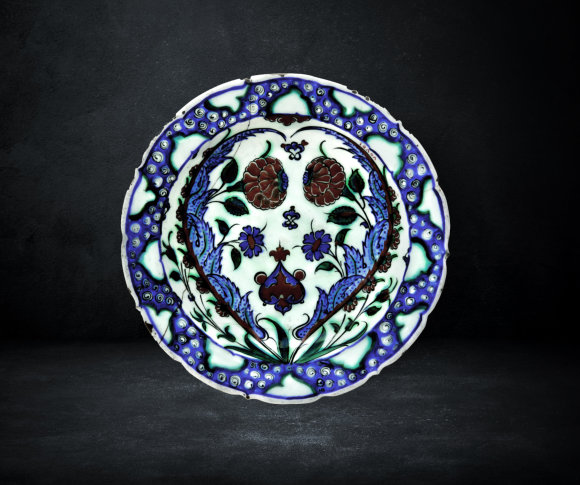
"Ottoman ceramic products ranged from dishes, bowls, ewers and goblets, to perfume bottles, vases, pilgrimage flasks, and lamp suspension eggs. Ottoman ceramics reached high levels of precision and perfection. They became very popular on the European markets. The group from which this specimen derives is attributed to several Turkish cities such as Iznik, Kütahya, and Gallipoli (Canakkale). The artifacts in this group are decorated with under glaze polychromic motifs on white slip depicting tulips, cloves, and lancelet leaves. The vegetal motifs have played a vital role in the Ottoman Arts, and were frequently utilized on the Ottoman artistic products. Some of these decorations had a symbolic significance to the Ottomans. European influences are also clear in the decoration of these items such as some Roman influence which is a mixture of stylized Islamic foliate ornaments applied on an European pattern
hall 12"

hall 12
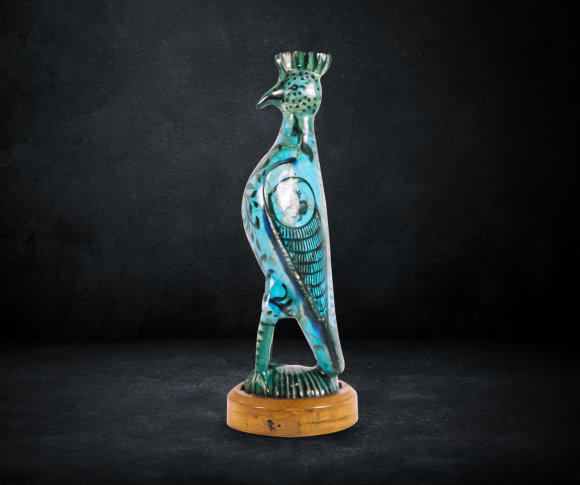
" Ceramic Statuette in the shape of a bird, probably used as a toy or as a decoration
Iran
6th -7thA.H / 12th - 13th A.D century
MIA no. 13294"
hall 15
"Wooden Heater,
painted under glaze and covered with ceramic tiles
Turkey or Damascus,
11th AH/17th century
MIA no. 7321"
"The decoration is applied under the transparent glaze based on interlaced foliate stems, lanceolate leave, and poly-lobed rosettes
hall 22"